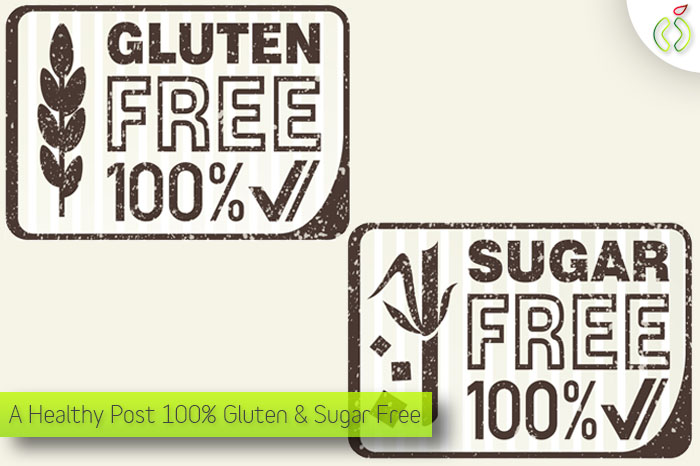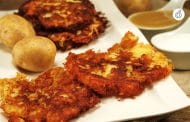If you’re anything like me and you’ve been paying attention to your health over the last few years you’ve probably heard about the negative effects of gluten and sugar. In my experience, gluten and sugar are two factors that are often responsible for frustrating progress on an otherwise healthy diet. Because of that minimising gluten and sugar consumption are two of the biggest “bang for your buck” changes people can make.
Speaking personally, I have found that when I keep gluten and refined sugar out of my diet for extended periods of time my health and performance improves on almost every level. I can think more clearly and concentrate better, I can train with more intensity and recover faster from workouts, I sleep better and don’t get tired as quickly. That said, I’m no angel! Every so often, I end up eating food that contains gluten and/or refined sugar. This can happen for many reasons including deliberate cheat meals, bad planning or social eating. No matter the reason, the sugar crash and unstable energy that follow reminds me why I had been avoiding gluten and sugar in the first place.
Background
If you’re going to try to minimise your consumption of gluten and sugar, or better yet avoid them completely, you should probably know why. Here’s a brief background on the negative health effects of refined sugar and gluten.
You can think of sugar as a shortcut. In order to survive, your body needs energy which it gets from digesting food. Refined sugar is very dense in energy but contains no essential nutrients like protein, vitamins or minerals. This is why people call sugar “empty calories”.
Because of the abundant, pure energy contained in sugar, it can harm teeth by providing convenient food for bacteria in your mouth. Refined sugar also plays havoc with your metabolism making it resistant to insulin which can lead to obesity, diabetes and heart disease. The bottom line is clear: avoiding refined sugar is vital if you want to live a healthy and enjoyable life. Like most shortcuts, sugar doesn’t help in the long run.
Gluten is the name for a group of proteins present in cereals like wheat and rye. Gliadin is the most harmful member of the gluten family and starts causing trouble in your digestive system. It can cause nutrient deficiencies, and digestive issues in celiacs as well as diarrhea, bloating depression and fatigue in people who are sensitive to gluten.
The variety of negative health outcomes linked to gluten consumption is staggering but the exact science of gluten sensitivity is still controversial among experts. However, I challenge anyone to completely avoid gluten for a month and not say they feel much better. I know I did when I cut out gluten.
Now that it’s clear why eating sugar and gluten is not a good idea the biggest question of the whole issue emerges: “What do I eat instead?”. Although people’s preferences are changing to include healthier options, sugar and gluten are still almost universally present in processed foods. This is just a feature of how world agriculture is organized. Sugar and wheat are massive commodities: according to the UN gluten-containing wheat is grown on more land than any other crop. No doubt this will take a long time to change. In the meantime, there are lots of good options for avoiding and replacing sugar and gluten. Here are some gluten free and sugar free recipes to get you started.
Recipe #1: Pancakes
There are plenty of good things to eat that don’t contain sugar, wheat or other cereals. Staples like meat, eggs and vegetables are some of the most satisfying things you can eat as long as they’re prepared with a little care. However, there are some really wonderful foods that used to rely on the texture of gluten and the sweetness of refined sugar. Pancakes are one of those foods. Thankfully, there are some great options to give you all the enjoyment of pancakes without the detrimental effects of sugar and gluten.
This recipe couldn’t be easier: it only has 2 main ingredients, it’s ready in a flash and can be varied by adding cinnamon or vanilla to the batter. As well as sweetening the pancakes, the bananas provide potassium which has been linked to lowering the risk of heart disease

Ingredients:
- 2 whole free range eggs
- 1 banana
- a pinch of baking soda
- small knob of butter for frying
- fresh fruit or berries to serve.
Blend the eggs, banana and baking soda together until they form a thick liquid. This is your pancake batter. Heat the butter in a skillet until it starts to bubble. Pour in enough batter to cover the base of the pan and cook on a low to medium heat for around 2 minutes or until set. Gently flip the pancake with a spatula and heat until the pancake is cooked through. Serve warm with fresh fruit or berries. This recipe serves 1 person, when cooking for larger groups scale the amounts up accordingly (i.e. 8 eggs and 4 bananas to serve 4).
Recipe #2: Pizza
Pizza is the quintessential junk food. Who doesn’t occasionally fantasize about devouring slice after slice of delicious, cheesey goodness? Unfortunately, pizza is a food based (literally) on gluten. Almost all conventional pizza bases are made from wheat, and a lot of the ones that aren’t are pretty disgusting! As well as containing gluten, pizzas frequently hide a lot of added sugar, mostly in the base and the tomato sauce although processed toppings can be quite sugary too.
The good news is that you don’t have to forego pizza if you want to stay gluten and sugar free. This recipe uses cauliflower to make a pizza base so as well as avoiding gluten and sugar you’ll be giving yourself a serving of vegetables that will keep you fuller for longer and provide most of your daily requirement of vitamin C.

Ingredients:
- 1 small head of cauliflower cut into small florets
- 50g mozzarella cheese (shredded)
- 1 egg lightly beaten
- ½ teaspoon salt
- ½ teaspoon oregano
- ½ teaspoon black pepper
To make the pizza base you need to process the cauliflower florets in a food processor until they have the consistency of rice. Then place them in a microwaveable bowl and cook in the microwave on high for 5 – 8 minutes until the cauliflower “rice” is tender. The next step is very important as the drier the cauliflower is the better the base will turn out. Place the cauliflower rice in a clean tea towel and squeeze out as much of the moisture as you can. Next, mix the cauliflower “rice” with all the other ingredients in a large bowl. Using your hands, shape the mixture into a disc on a lined baking sheet.
Top with your favourite sugar free tomato sauce, cheese and toppings and bake at 450°F (220°C) for 12 – 15 minutes.
Recipe #3: Treat Bars
Ok, I’ll admit it, the one thing that gluten and sugar are really good at is making cake. But once you realise that cakes containing gluten and sugar are working against you and your goals, they don’t taste so sweet.
Having a gluten and sugar free alternative to sweet baked goods is a great way to stop cravings before they happen. This recipe is really satisfying getting sweetness from dried fruit and a decent amount of protein and fat from the nuts. What’s more, it’s really versatile so feel free to experiment with different nuts, nut butters and dried fruits.

Ingredients:
- 200g mixed nuts (blended in a food processor)
- 150g desiccated coconut
- 100g raisins
- 150g nuts butter (I use natural peanut butter)
- 200g coconut oil
- 100g 70% dark chocolate
Combine the dry ingredients in a large mixing bowl. Melt the coconut oil, nut butter and chocolate over gentle heat in a double boiler. Once fully melted, add the wet ingredients to the dry ingredients and combine thoroughly. Press the mixture into a shallow dish and leave in the fridge for an hour or two. Once the mix has stiffened up cut into serving-sized bars (don’t be greedy!) and enjoy!
It’s good to note that while these bars have no added sugar, the dried fruit does contain some natural sugars. However, in combination with the fibre and macronutrients of the other ingredients this isn’t a problem. But be warned: they are incredibly moreish which leads me on to my final point . . .
It’s all too easy to think that just because gluten and sugar free foods are good choices then, by extension, they’re perfect and cannot possibly have any negative effects. This is a trap I have occasionally fallen into so I wanted to include this word of caution. Avoiding gluten and sugar is important and can be incredibly helpful in staying healthy but it isn’t the whole story.
While gluten-free, sugar-free recipes make great alternatives to low quality food choices, they are not magic. Just because something has no gluten or sugar doesn’t mean that you can eat it in excess without any consequences for your health, appearance or performance. Gluten and sugar free foods are healthier but they still contain calories. If you want to get fitter, stronger or leaner you need to pay attention to the total energy content of your food and not just whether or not it contains gluten or sugar. Translation: don’t eat the treat bars all at once!
Any more recipes you would recommend? Let me know with a comment.






